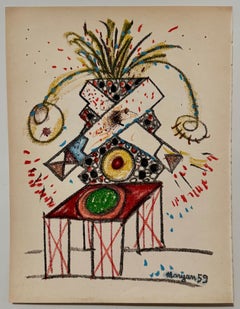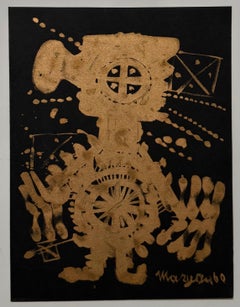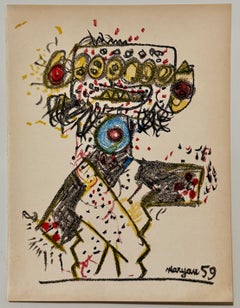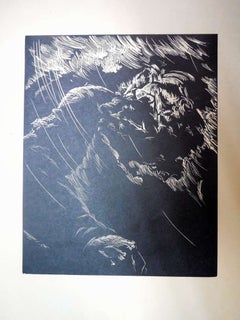Want more images or videos?
Request additional images or videos from the seller
1 of 5
Arthur KolnikShtetl Scene Expressionist woodcut
$225List Price
About the Item
- Creator:Arthur Kolnik (1890 - 1972, Polish, Ukrainian)
- Dimensions:Height: 14 in (35.56 cm)Width: 10 in (25.4 cm)
- Medium:
- Movement & Style:
- Period:
- Condition:
- Gallery Location:Surfside, FL
- Reference Number:1stDibs: LU38210500732
About the Seller
4.9
Platinum Seller
Premium sellers with a 4.7+ rating and 24-hour response times
Established in 1995
1stDibs seller since 2014
1,841 sales on 1stDibs
Typical response time: 1 hour
Authenticity Guarantee
In the unlikely event there’s an issue with an item’s authenticity, contact us within 1 year for a full refund. DetailsMoney-Back Guarantee
If your item is not as described, is damaged in transit, or does not arrive, contact us within 7 days for a full refund. Details24-Hour Cancellation
You have a 24-hour grace period in which to reconsider your purchase, with no questions asked.Vetted Professional Sellers
Our world-class sellers must adhere to strict standards for service and quality, maintaining the integrity of our listings.Price-Match Guarantee
If you find that a seller listed the same item for a lower price elsewhere, we’ll match it.Trusted Global Delivery
Our best-in-class carrier network provides specialized shipping options worldwide, including custom delivery.You May Also Like
E. Strache, Handzeichnungen folio, "Female Model, Seated" Collotype plate
By (after) Egon Schiele
Located in Palm Beach, FL
After Egon Schiele (1890 – 1918), AUSTRIA
“ART CANNOT BE MODERN, ART IS PRIMORDIALLY ETERNAL.” -SCHIELE
Defiantly iconoclastic in life and art, Egon Schiele is esteemed for his mas...
Category
1920s Vienna Secession Figurative Prints
Materials
Paper
$19,500
H 18.75 in W 11.5 in
"Brotherhood" lithograph by Käthe Kollwitz
By Käthe Kollwitz
Located in Soquel, CA
Bold print of "Brotherhood" by Kathe Kollwitz (German, 1867-1945). This piece is one of the Lithographic reproductions of the original lithographs, plate 3 from a series of 10, print...
Category
1940s Expressionist Figurative Prints
Materials
Paper, Ink, Lithograph
E. Strache, Handzeichnungen folio, "Nursing Mother with Child" Collotype plate
By (after) Egon Schiele
Located in Palm Beach, FL
after Egon Schiele (1890 – 1918), AUSTRIA
“ART CANNOT BE MODERN, ART IS PRIMORDIALLY ETERNAL.” -SCHIELE
Defiantly iconoclastic in life and art, Egon Schiele is esteemed for his mas...
Category
1920s Vienna Secession Figurative Prints
Materials
Paper
$3,200
H 18.75 in W 11.5 in
Excelsior by Simon Tozer, Limited edition, Sailing, Landscape, Figurative art
By Simon Tozer
Located in Deddington, GB
Excelsior by Simon Tozer [2021]
limited_edition and hand signed by the artist
Screenprint on Paper
Edition number of 30
Image size: H:23 cm x W:30 cm
...
Category
21st Century and Contemporary Expressionist Landscape Prints
Materials
Paper, Screen
$129
H 13.78 in W 19.69 in D 0.04 in
They Thunder forth from Their Clouds-Lithograph by George Grosz - 1922
By George Grosz
Located in Roma, IT
They Thunder forth from Their Clouds is an original lithograph, realized by George Grosz in 1922, from Die Raüber, edition Malik Verlag in 100 prints, plate n°8 da Die Raüber, hand-signed in pencil.
"They thunder forth from their clouds about gentleness and forbearance, while they sacrifice human victims to the God of love." (Da donnern sie Sanftmut und Duldung aus ihren Wolken und bringen dem Gott der Liebe Menschenopfer.)"
Sheet dimension: 61,5 x 42 cm.
In very good conditions.
Here representing a man in front of cross miserably praying, below of his feet laid down many dead bodies and ruined part of the city. here is one of his artwork affected by consequences drama of war.
George Grosz (1893 -1959) was a German artist known especially for his caricatural drawings and paintings of Berlin life in the 1920s. He was a prominent member of the Berlin Dada and New Objectivity group during the Weimar Republic.
He studied drawing at the Dresden Academy 1909-11 and at the School of Arts and Crafts in Berlin 1912-14, He was in the army 1914-15 and again for a short time in 1917, but spent the rest of the war in Berlin where he made violently anti-war drawings...
Category
1920s Expressionist Figurative Prints
Materials
Lithograph, Paper
$3,388
H 24.22 in W 16.54 in D 0.04 in
Ducks Quacking, Cactus Peeking, linear style, monochromatic
By Jenny Toth
Located in Brooklyn, NY
This is an artist proof aquatint of a woman peeking around a cactus with ducks mysteriously hovering in the upper right corner and a giant beautiful cactus overgrowing. The mood is ...
Category
2010s Expressionist Figurative Prints
Materials
Paper, Ink, Archival Ink, Aquatint
$600
H 17 in W 14.5 in D 0.6 in
Maryan (Pinchas Burstein), Polish-Israeli artist, Autumn 1975 Lithograph 25x21in
By Pinchas Maryan
Located in Miami, FL
Maryan S Maryan (Pinchas Burstein) (Poland, 1927-1977)
'Autumn', 1975, Lithograph on paper, 25 x 21 in., Edition of 75
Ref: BUR1102-001
Maryan S. Maryan (Pinchas Burstein), a renown...
Category
1970s Expressionist Prints and Multiples
Materials
Paper, Lithograph
Maryan (Pinchas Burstein), Polish-Israeli artist, Summer 1975 lithograph 25x21in
By Pinchas Maryan
Located in Miami, FL
Maryan S Maryan (Pinchas Burstein) (Poland, 1927-1977)
'Summer', 1975, Lithograph on paper, 21x25 in., Edition of 75
Ref: BUR1102-004
Maryan S. Maryan (Pinchas Burstein), a renowned...
Category
1970s Expressionist Prints and Multiples
Materials
Paper, Lithograph
Herve Telemaque, "La pêche miraculeuse", 2005, Engraving, 39.4x31.9 in
By Herve Telemaque
Located in Miami, FL
Herve Telemaque (France, 1937-2022)
'La pêche miraculeuse', 2005
silkscreen on canvas
39.4 x 31.9 in. (100 x 81 cm.)
Edition of 99
Unframed
ID: TEL1361-013-106
Category
Early 2000s Expressionist Prints and Multiples
Materials
Paper, Engraving, Screen
$2,000
H 39.4 in W 31.9 in
Togores, Figurative Composition, Hand Signed Large Lithograph, 1960s, Framed
By Josep de Togores
Located in Barcelona, ES
Framed Rare Hand-Signed Lithography by Togores Experience the artistry of Togores with this framed rare hand-signed lithography, an exceptional piece from the important artist known ...
Category
1920s Expressionist Figurative Prints
Materials
Paper
$3,210
H 33.86 in W 25.6 in D 1.38 in
More From This Seller
View AllPolish French Figurative Abstract Art Brut Expressionist Lithograph Maryan
By Pinchas Maryan
Located in Surfside, FL
Pinchas Burstein, known as Maryan
Lithograph (after the drawing).
1960
Dimensions: 12 3/8 x 9 3/8 inches (315 x 240mm).
There is printed text on the back, as issued.
Signed in the...
Category
1960s Expressionist Figurative Prints
Materials
Paper, Lithograph
Polish French Figurative Abstract Art Brut Expressionist Lithograph Maryan
By Pinchas Maryan
Located in Surfside, FL
Pinchas Burstein, known as Maryan
Lithograph (after the drawing).
1960
Dimensions: 12 3/8 x 9 3/8 inches (315 x 240mm).
Gold or bronze ink on black paper
Signed in the plate, not b...
Category
1960s Expressionist Figurative Prints
Materials
Paper, Lithograph
Polish French Figurative Abstract Art Brut Expressionist Lithograph Maryan
By Pinchas Maryan
Located in Surfside, FL
Pinchas Burstein, known as Maryan
Lithograph (after the drawing).
1960
Dimensions: 12 3/8 x 9 3/8 inches (315 x 240mm).
There is printed text on the back, as issued.
Signed in the...
Category
1960s Expressionist Figurative Prints
Materials
Paper, Lithograph
Expressionist Windy Day Portrait
By Arthur Kolnik
Located in Surfside, FL
Arthur Kolnik was born in Stanislavov, a small town in Galicia, which was then part of the Austro-Hungarian Empire. His father, who was originally from Lithuania, worked as an accoun...
Category
1930s Expressionist Figurative Prints
Materials
Paper
Shtetl Scene Expressionist woodcut
By Arthur Kolnik
Located in Surfside, FL
Arthur Kolnik was born in Stanislavov, a small town in Galicia, which was then part of the Austro-Hungarian Empire. His father, who was originally from Lithuania, worked as an accoun...
Category
1930s Expressionist Figurative Prints
Materials
Paper
Apeles Fenosa Spanish Sculptor Mourlot Lithograph Abstract Expressionist Figures
By Apelles Fenosa
Located in Surfside, FL
This is from a hand signed, limited edition (edition of 125) folio or full page lithographs some having a poem verso. The individual sheets are not signed or numbered. This listing ...
Category
1970s Expressionist Figurative Prints
Materials
Lithograph
Recently Viewed
View AllMore Ways To Browse
Dali Stone
Damien Hirst Butterfly Prints
Edward Mayer
Eiffel Tower Lithograph
Florence Etching
Fruit Engraving
Grosvenor School
Guido Crepax
Haring Subway Drawing
Japanese Print Actors
Keith Haring Aids
Keith Haring Catalog
Lee Miller
Marcel Broodthaers
Murakami Screen Print
Picasso Chevre
Raphael Soyer On Sale
Romero Britto On Sale



